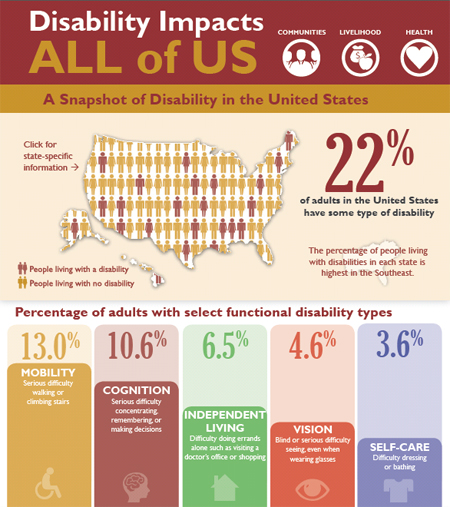CDC: 53 million adults in the US live with a disability
New report provides state-by-state data on disability types
Press Release
Embargoed Until: Thursday, July 30, 2015, 1:00 p.m. ET Disability Impacts ALL of US.
Contact: 
Entire Infographic
In the United States, one out of every five adults has a disability, according to a new study published by the Centers for Disease Control and Prevention. The most common functional disability type was a mobility limitation – defined as serious difficulty walking or climbing stairs — reported by one in eight adults, followed by disability in thinking and/or memory, independent living, vision, and self-care.
The researchers found that the highest percentages of people with disabilities are generally in Southern states, for example Alabama (31.5 percent), Mississippi (31.4 percent), and Tennessee (31.4 percent). The report did not determine why differences occur by state; however, states in the South tend to have some of the higher rates of chronic diseases, such as heart disease and diabetes, which may also be associated with disability.
“We are all at risk of having a disability at some point in our lifetime,” said CDC Director Tom Frieden, M.D., M.P.H. “Health professionals and health care systems need to meet the needs of this growing population.”
The report also revealed that non-Hispanic black (29 percent) and Hispanic (25.9 percent) adults were more likely to have a disability than were white non-Hispanic (20.6 percent) adults. Those with lower education levels, lower incomes, and those who are unemployed were also more likely to report a disability.
“For the past 25 years, the Americans with Disabilities Act (ADA) has made a positive difference in the lives of those who have disabilities by ensuring better access to buildings, transportation, and employment. Access to preventive health care is also critically important for those with disabilities,” said Georgina Peacock, M.D., M.P.H., Director of CDC’s Division of Human Development and Disability. “Many of the health issues that people with disabilities face may be addressed by making sure they have access to health promotion programs and health care services, including preventive health screenings, throughout their lifespan.”
CDC is committed to protecting the health and well-being of people with disabilities throughout their lives. Through its state-based disability and health programs and national collaborations, CDC will continue to work to reduce health disparities faced by people with disabilities by facilitating their inclusion in public health surveys, public health programs, emergency preparedness and planning efforts, and accessible health care services. To work toward this goal, CDC provides data, information and resources for public health practitioners, health care providers, and people interested in the health and well-being of people with disabilities.
Although disability information has been collected in national surveys for many years, this was the first time that functional disability type was included in the Behavioral Risk Factor Surveillance System (BRFSS). The BRFSS is an annual, state-based telephone survey conducted by states in collaboration with CDC that gathers information on demographics, health status, health behaviors and disabilities.
More information about CDC’s work to support inclusive public health and health care settings is available at http://www.cdc.gov/disabilities .